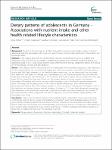Dietary patterns of adolescents in Germany - Associations with nutrient intake and other health related lifestyle characteristics
Richter, Almut
Heidemann, Christin
Schulze, Matthias B.
Roosen, Jutta
Thiele, Silke
Mensink, Gert
Background:The aim of this study was to identify dietary patterns among a representative sample of German adolescents and their associations with energy and nutrient intake, socioeconomic and lifestyle characteristics, and overweight status. Methods: In the analysis, data from the German Health Interview and Examination Survey for Children and Adolescents were used. The survey included a comprehensive dietary history interview conducted among 1272 adolescents aged 12 to 17 years. Dietary patterns were determined with principal component analysis (PCA) based on 48 food groups, for boys and girls separately. Results: Three dietary patterns among boys and two among girls were identified. Among boys, high adherence to the 'western' pattern was associated with higher age, lower socioeconomic status (SES), and lower physical activity level (PA). High adherence to the 'healthy' pattern among boys, but not among girls, was associated with higher SES, and higher PA. Among boys, high adherence to the 'traditional' pattern was associated with higher age. Among girls, high adherence to the 'traditional and western' pattern was associated with lower age, lower SES and more hours watching TV per day. The nutrient density of several vitamins and minerals, particularly of B-vitamins and calcium, increased with increasing scores of the 'healthy' pattern among both sexes. Conversely, with increasing scores of the 'western' pattern among boys, most nutrient densities decreased, particularly of fibre, beta-carotene, vitamin D, biotin and calcium. Among girls with higher scores of the 'traditional and western' pattern, nutrient densities of vitamin A, C, E, K and folate decreased. Among boys, high adherence to the 'traditional' pattern was correlated with higher densities of vitamin B12 and vitamin D and lower densities of fibre, magnesium and iron. No significant associations between dietary patterns and overweight were found. Conclusions: Higher scores for dietary patterns characterized by higher consumption of take away food, meat, confectionary and soft drinks ('western' and 'traditional and western') were found particularly among 16- to 17-years old boys and among adolescents with lower SES. These patterns were also associated with higher energy density, higher percent of energy from unsaturated fatty acids and lower percent of energy from carbohydrates as well as lower nutrient densities of several vitamins and minerals. Therefore, nutritional interventions should try to focus more on adolescents with lower SES and boys in general.
Dateien zu dieser Publikation
Keine Lizenzangabe

